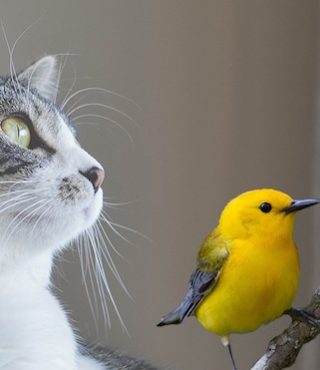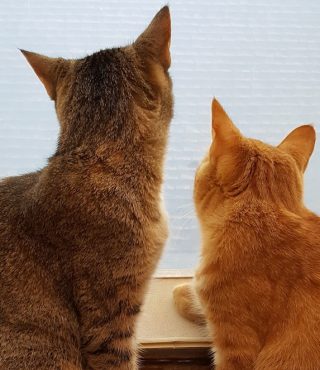The Calgary Model: Encouraging Responsible Pet Ownership

Calgary is a model for a successful approach to animal control. Low rates of euthanasia and high return-to-owner and bylaw compliance rates have municipalities around the world taking notes from Calgary’s animal control department. (Calgary also won the inaugural Safe Cats, Safe Birds Award for Municipalities.)
Bill Bruce knew little about animal control when he took over the department. Now retired, the former Director of Animal Services and Bylaws in Calgary is credited with creating what is considered by many to be the best animal control model in the world.
“People are interested in why Calgary has such a low euthanasia rate compared to other cities,” said Bill Bruce, architect of Calgary’s system, in an interview in 2010, “It’s been a journey. Calgary back in 1985 was as bad as anywhere else.”
But how? What does the model look like?
The first radical innovation: collaboration. “We brought everyone to the table,” explains Bill Bruce. ‘Everyone’ included veterinarians, rescue organizations, trainers, dog breeders, cat fanciers, and behaviorists. “We stopped the fighting between the organizations.” Calgary’s animal control program involves four main organizations – Animal Services, the Humane Society of Calgary, the MEOW Foundation, and the Animal Rescue Foundation, a volunteer foster group, and all stakeholders were involved in formulating the plan.
The second: public education. Bruce credits the responsible pet ownership philosophy for much of the city’s success. Educating owners about the benefits to their pets and their community of responsible practices started in Calgary before the introduction of licensing and no-roam bylaws. The city does collaborative events in parks and city venues, and has a school program to educate youth about responsible pet ownership.
The third: build an animal services department that actually provides services to animals, such as reuniting them with their owners, spay-neuter, emergency medical care, etc.
The fourth: train animal control offers in community relations and conflict resolution so they can address as many issues as possible out in the community, preventing the animals from ending up in a shelter.
The fifth: compassion. The department has the power to waive license fees for low-income residents. Calgary firefighters are all trained in pet CPR, and carry pet-size oxygen mask adapters for their equipment. If Calgary police go to a scene of domestic abuse and the woman needs to leave, the police bring the pets to the city shelter, and staff find foster care for the animals and reunite them with the owner when her housing permits.
Public communications around responsible pet ownership focus on calling for everyone to take these actions:
• License and provide permanent identification for your pets.
• Spay or neuter your pets.
• Provide training, socialization, proper diet, and medical care for your pets.
• Do not allow your pets to become a threat or nuisance in the community (no roaming unsupervised, excessive barking, etc)
• Procure your pet ethically and from a credible source.
Though these points are straightforward, if all pet owners in a community did them, the majority of the community’s animal issues would be solved. Bruce explained, “Licensing and identification quickly reunite lost pets with their families; spay and neuter initiatives reduce unwanted litters humanely; proper training and care produces safe, healthy animals; and proper management prevents pets from becoming a threat or nuisance, and reduces community complaints about animals.”
These are the main features of Calgary’s model as they pertain to cats:
• mandatory licensing for cats without permanent ID;
• a no-roam bylaw;
• all animals adopted from shelters are spayed or neutered;
• licensing fees and fines cover the costs of enforcement and sheltering;
• strong public communications around Responsible Pet Ownership, the benefits and importance (for the individual cat, the overall cat population, and for the community itself) of compliance;
• a school program to educate youth about responsible pet care;
• incentivizing compliance: the ‘promise to return’ lost pets (licensing ensures your pet gets ‘a ride home’ if they get lost) and a rewards program for license holders (discounts at local retailers);
• a proactive community relations / enforcement approach; helping neighbours resolve animal-related conflicts;
• a subsidized spay/neuter program for low-income residents;
• a feral cat-care plan and program in concert with a non-profit, the Meow Foundation.
Here are a few stats demonstrating Calgary’s success:
• Calgary has the highest rates of licensing compliance in the country: 90% for dogs and 50% for cats. (The average for cats is 5-10%.)
• 47% of cats brought in to the shelter in 2012 were reunited with their owners, and a further 25% were adopted out to new homes. (The national average for cats being reclaimed from shelters is around 5%.)
• more than 10,000 animals have been sterilized through the no-cost spay/neuter program between 2006 and 2016
• 97 cats entered unowned cat-care programs via the Meow Foundation in 2009; by 2016 that number was only 48.
Below are some resources with more information about the Calgary model, including a presentation by Bill Bruce, “Building Responsible Pet Ownership Communities: the Calgary Model”, a copy of the Calgary Animal Control Bylaw, and the Calgary Responsible Cat Ownership Brochure.
If your community is interested in adopting the Calgary model, we can help! Contact us at info@catsandbirds.ca.
Bill Bruce: Building Responsible Pet Ownership Communities








